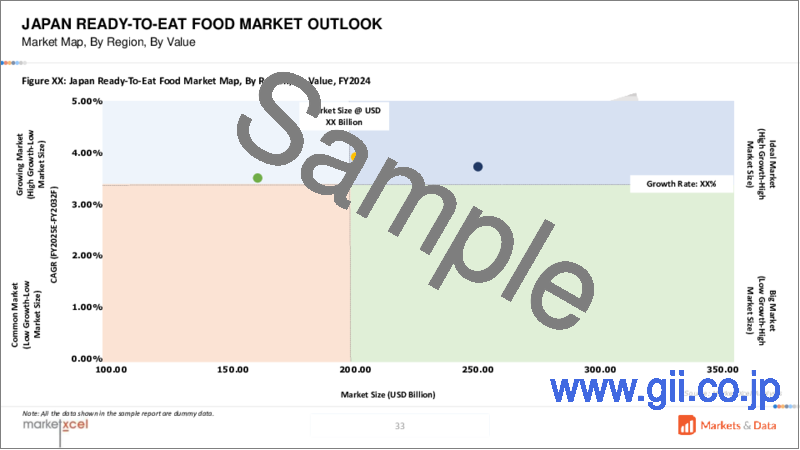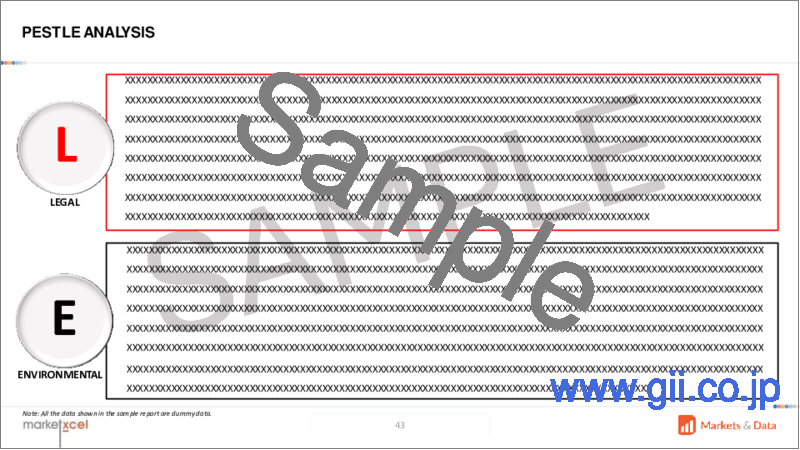|
|
市場調査レポート
商品コード
1328995
日本の調理済み食品市場:カテゴリー別、包装タイプ別、流通チャネル別、エンドユーザー別、地域別、機会、予測、2017年~2031年Japan Ready-To-Eat Food Market Assessment, By Category, By Packaging Type, By Distribution Channel, By End-user, By Region, Opportunities, and Forecast, FY2017-FY2031F |
||||||
カスタマイズ可能
|
|||||||
| 日本の調理済み食品市場:カテゴリー別、包装タイプ別、流通チャネル別、エンドユーザー別、地域別、機会、予測、2017年~2031年 |
|
出版日: 2023年08月14日
発行: Markets & Data
ページ情報: 英文 90 Pages
納期: 3~5営業日
|
- 全表示
- 概要
- 図表
- 目次
日本の調理済み(RTE)食品の市場規模は、2024年~2031年の予測期間中に4.03%のCAGRがが見込まれています。同市場は、2023年の81億4,000万米ドルから、2031年には111億7,000万米ドルに達すると予測されています。日本ではここ数年、多忙なライフスタイルや共働き世帯の増加により、調理済み食品の需要が拡大しています。2020年以降のパンデミックの「巣ごもり需要」は、市場のさらなる拡大に寄与しています。日本冷凍食品協会の報告によると、家庭用冷凍食品の年間出荷額は2017年に初めて22億3,000万米ドルの大台を超え、2021年には29億1,000万米ドルと過去最高水準に達しました。特に、高価な商品の品揃えが豊富になり、顧客が家庭でグルメな食事を用意できるようになっています。
同国では婚姻率と年齢が低下しており、単身世帯が増加しています。また、女性の社会進出が進み、料理や共食の時間が減っています。こうした要因にパンデミックの影響が加わり、惣菜や宅配サービスの需要が高まっています。首都圏では、調理済み米飯や、弁当、おにぎり、サンドウィッチ、コロッケ、野菜サラダなどの日配品を主に提供しています。これらの商品は主にコンビニエンスストア、専門店、食品スーパーを通じて流通しています。
あらゆる国の中で、日本は最も急速に高齢化が進んでいます。内閣府の2022年版高齢社会白書によると、日本の65歳以上の人口は3,621万人強で、日本の総人口の28.9%を占めています。日本の高齢化は、調理済み食品(RTE)市場を含むさまざまな産業に影響を及ぼす重要な人口動向です。高齢になるにつれて、身体的制限や運動能力の低下が生じ、手の込んだ食事を作ることがより困難になってきます。電子レンジで温めるだけの食事や包装済みのオプションなど、調理が簡単なRTE食品は、便利で手間のかからない食事ソリューションを必要とする高齢消費者のニーズに応えるものです。高齢者では食事のニーズが異なることが多く、少なめの分量や特定の栄養面での配慮を必要とする場合もあります。RTE食品メーカーはこれを認識し、低ナトリウム含有量や必須栄養素の強化など、高齢消費者の栄養要件に合わせた製品を開発しています。全体として、日本の高齢化はRTE食品市場に課題と機会をもたらしています。高齢消費者特有のニーズと嗜好を理解することで、RTE食品メーカーはこの層に対応した製品を開発し、便利で栄養バランスの取れた、利用しやすい食事の選択肢を提供することができます。
当レポートでは、日本の調理済み食品市場について調査し、市場の概要とともに、カテゴリー別、包装タイプ別、流通チャネル別、エンドユーザー別、地域別動向、および市場に参入する企業のプロファイルなどを提供しています。
目次
第1章 調査手法
第2章 プロジェクトの範囲と定義
第3章 COVID-19による日本の調理済み食品市場への影響
第4章 エグゼクティブサマリー
第5章 お客様の声
第6章 日本の調理済み食品市場の見通し、2017年~2031年
- 市場規模と予測
- カテゴリー別
- インスタント朝食/シリアル
- インスタントスープとスナック
- 焼き菓子
- 肉/鶏肉
- その他
- 包装タイプ別
- 缶詰
- 冷凍または冷蔵
- レトルト
- その他
- 流通チャネル別
- オンライン
- オフライン
- エンドユーザー別
- 住宅
- 食品サービス
- 機関
- 地域別
- 企業別市場シェア(%)、2023年
第7章 市場マッピング、2023年
- カテゴリー別
- 包装タイプ別
- 流通チャネル別
- エンドユーザー別
- 地域別
第8章 マクロ環境と産業構造
- 需給分析
- 輸出入分析
- バリューチェーン分析
- PESTEL分析
- ポーターのファイブフォース分析
第9章 市場力学
第10章 主要参入企業の情勢
- 市場リーダー上位5社の競合マトリックス
- 市場リーダー上位5社の市場収益分析(%、2023年)
- 合併および買収/合弁事業(該当する場合)
- SWOT分析(市場参入企業5名向け)
- 特許分析(該当する場合)
第11章 価格分析
第12章 ケーススタディ
第13章 主要企業の見通し
- Ryohin Keikaku Co., Ltd
- Nagatanien Holdings Co., Ltd.
- Asahi Group Foods, Ltd.
- Maruha Nichiro Corporation
- Nissin Foods (USA) Co., Inc.
- Ajinomoto Co., Inc.
- Yamazaki Baking Co., Ltd.
- Benihana Inc.
- SL Creations Co., Ltd.
- House Foods Group Inc.
第14章 戦略的推奨事項
第15章 お問合せと免責事項
List of Tables
- Table 1. Pricing Analysis of Products from Key Players
- Table 2. Competition Matrix of Top 5 Market Leaders
- Table 3. Mergers & Acquisitions/ Joint Ventures (If Applicable)
- Table 4. About Us - Regions and Countries Where We Have Executed Client Projects
List of Figures
- Figure 1. Japan Ready-To-Eat Food Market, By Value, In USD Billion, FY2017-2031F
- Figure 2. Japan Ready-To-Eat Food Market, By Volume, In Unit Thousand, FY2017-2031F
- Figure 3. Japan Ready-To-Eat Food Market Share, By Category, In USD Billion, FY2017-2031F
- Figure 4. Japan Ready-To-Eat Food Market Share, By Packaging Type, In USD Billion, FY2017-2031F
- Figure 5. Japan Ready-To-Eat Food Market Share, By Distribution Channel, In USD Billion, FY2017-2031F
- Figure 6. Japan Ready-To-Eat Food Market Share, By End-User, In USD Billion, FY2017-2031F
- Figure 7. Japan Ready-To-Eat Food Market Share, By Region, In USD Billion, FY2017-2031F
- Figure 8. By Category Map-Market Size (USD Billion) & Growth Rate (%), FY2023
- Figure 9. By Packaging Type Map-Market Size (USD Billion) & Growth Rate (%), FY2023
- Figure 10. By Distribution Channel Map-Market Size (USD Billion) & Growth Rate (%), FY2023
- Figure 11. By End-User Map-Market Size (USD Billion) & Growth Rate (%), FY2023
- Figure 12. By Region Map-Market Size (USD Billion) & Growth Rate (%), FY2023
Japan Ready-To-Eat Food Market is expected to witness a CAGR of 4.03% during the forecast period FY2024-FY2031. The market was valued at USD 8.14 billion in FY2023 and is anticipated to reach USD 11.17 billion by FY2031. The demand for ready-to-eat foods has been growing in Japan over the past few years due to busier lifestyles and increased households with double incomes. The pandemic's "nesting demand" since 2020 has contributed to further market expansion. The Japan Frozen Food Association reports that annual shipments of frozen food for home use passed the USD 2.23 billion mark for the first time in 2017 and reached the highest level ever recorded in 2021 at USD 2.91 billion. Particularly, a wider selection of expensive goods is readily available, enabling customers to prepare gourmet meals at home.
The marriage rate and age in the country are declining, resulting in an increase in single-person households. Additionally, the growing number of women in the workforce leaves less time for cooking and shared meals. These factors, compounded by the impact of the pandemic, are driving a higher demand for ready-to-eat meals and home delivery services. In the Tokyo metropolitan area, ready-to-eat food suppliers primarily offer products such as cooked rice and daily dishes, including lunch boxes, rice balls, sandwiches, croquettes, and vegetable salads. These items are predominantly distributed through convenience stores, specialty stores, and food supermarkets.
Aging Population
Out of all nations, Japan is experiencing the fastest rate of population aging. The Cabinet Office's 2022 White Paper on Ageing Society estimates that there are just over 36.21 million people in Japan who are 65 years or older making 28.9% of the country's total population. The aging population in Japan is a significant demographic trend that has implications for various industries, including the ready-to-eat (RTE) food market. As individuals age, they experience physical limitations or reduced mobility, making it more challenging for them to cook elaborate meals. RTE food products that are easy to prepare, such as microwavable meals or pre-packaged options, cater to the needs of older consumers who require convenient and hassle-free meal solutions. Older adults often have different dietary needs and may require smaller portion sizes or specific nutritional considerations. RTE food manufacturers are recognizing this and developing products that are tailored to the nutritional requirements of older consumers, such as lower sodium content or fortified with essential nutrients. Overall, Japan's aging population presents challenges and opportunities for the RTE food market. By understanding the unique needs and preferences of older consumers, RTE food manufacturers can develop products that cater to this demographic, providing convenient, nutritionally balanced, and accessible meal options.
Busy Work Schedules
The Health, Labour and Welfare Ministry projects that there will be only 60.82 million people of working age in 2025 and 52.45 million in 2040, down from the 65.3 million people of working age in 2017. Besides this, over the past two decades, the consumption of frozen foods has doubled and is still rising. T he popularity of ready-to-eat meals is rising as at-home cooking has been steadily declining. The busy lifestyle of consumers in Japan is a significant driver of the ready-to-eat (RTE) food market. With increasingly busy work schedules, Japanese consumers have less time to prepare meals at home. Consumers, especially those working long hours or juggling multiple responsibilities, seek convenient and time-saving meal options. Busy individuals often live alone or have smaller households. RTE food products are often available in single-serve portions, catering to the needs of consumers who prefer individual-sized meals. This eliminates the need for extensive meal planning or dealing with leftovers, providing convenience and reducing waste. Consumers can simply heat, open, or assemble the ready-to-eat items, saving precious time and effort in the kitchen.
Growing Women Workforce
The female participation rate in the country's workforce rose significantly from 48.06 percent in 2012 to 53.97 percent in 2022. The growing number of women entering the workforce in Japan has a significant impact on the demand for ready-to-eat food. As more women pursue careers, they often face time constraints and busy schedules, leaving them with less time to cook elaborate meals at home. This shift in lifestyle and increased work responsibilities create a greater need for convenient and time-saving food options, such as ready-to-eat meals. These pre-packaged meals allow working women to have quick and easily accessible food solutions without compromising on nutrition or taste. The convenience and efficiency offered by ready-to-eat food products align well with the demands and time constraints of women in the workforce, thus driving their demand in Japan.
Increasing Single-Person Households
Single-person households are playing a significant role in driving the demand for ready-to-eat food products in Japan. As the number of people living alone increases, a growing segment of the population seeks convenient and quick meal solutions. Cooking full meals for one person can be time-consuming and may result in food wastage, making ready-to-eat food products an appealing option. Ready-to-eat food products cater perfectly to the needs of single individuals who need more time, cooking skills, or inclination to prepare elaborate meals. These pre-packaged meals offer a variety of options, from single-serving portions to diverse cuisines, providing a convenient and satisfying dining experience for individuals living alone.
Additionally, single-person households often include working professionals and young adults who have busy schedules, further driving the demand for quick and easy meal options. The desire for convenience and the need to manage time efficiently contribute to this demographic's popularity of ready-to-eat food products. In April 2022, HelloFresh SE ("HelloFresh") commenced its official service in Japan. Japanese customers now have access to a distinctive blend of convenient, time-saving, and delicious home-cooked meals, perfectly tailored to suit busy lifestyles of single people.
Impact of COVID-19
The COVID-19 pandemic has significantly impacted Japan's ready-to-eat (RTE) food market, leading to challenges and opportunities. there was a surge in demand for packaged and RTE food products as consumers turned to convenient, shelf-stable options. With restrictions on dining out and increased emphasis on hygiene, consumers sought RTE food products as a safe and practical choice. With more people working from home and spending more time indoors, changes in meal patterns, including increased snacking and a greater emphasis on quick and easy meal solutions, influenced the demand for RTE food products. E-commerce platforms and food delivery services experienced a surge in demand, providing opportunities for RTE food manufacturers to reach consumers directly. The Japanese processed food market has historically been thought to be challenging to break into due to the strict regulations. Despite this, the country holds significant potential.
Key Players Landscape and Outlook
The ready-to-eat (RTE) food market in Japan is highly competitive, with a wide range of local and international players operating. Some key players in the RTE food market in Japan are Ryohin Keikaku Co., Ltd., Asahi Group Foods, Ltd., Ajinomoto Co., Inc. and Yamazaki Baking Co., Ltd. The outlook for the RTE food market in Japan is positive, with increasing demand for convenient and time-saving meal options among consumers.
The COVID-19 pandemic also increased the demand for RTE food products, with more consumers opting for packaged foods and snacks for safety and convenience reasons who sought out foods and beverages to prepare at home that were as tasty as those found in restaurants, simple to prepare, and healthy. The market is expected to continue to grow, with RTE food manufacturers introducing new and innovative products that cater to changing consumer preferences, such as healthier, plant-based, and eco-friendly options. However, the market faces challenges such as increasing competition, price sensitivity among consumers, and concerns over the quality and nutritional value of RTE food products.
Table of Contents
1. Research Methodology
2. Project Scope & Definitions
3. Impact of COVID-19 on Japan Ready-To-Eat Food Market
4. Executive Summary
5. Voice of Customer
- 5.1. Demographics (Age/Cohort Analysis - Baby Boomers and Gen X, Millennials, Gen Z; Gender; Income - Low, Mid and High; Geography; Nationality; etc.)
- 5.2. Market Awareness and Product Information
- 5.3. Brand Awareness and Loyalty
- 5.4. Factors Considered in Purchase Decision
- 5.4.1. Brand Name
- 5.4.2. Pack Size
- 5.4.3. Price
- 5.4.4. Customisation Options
- 5.4.5. Packaging Type
- 5.4.6. Inclination Towards Organic Products
- 5.4.7. Promotional Offers & Discounts
- 5.5. Purpose of Purchase (Personal Use, Gifting)
- 5.6. Frequency of Purchase
- 5.7. Medium of Purchase
- 5.8. Role of Brand Ambassador or Influencer Marketing on Product/Brand Absorption
6. Japan Ready-To-Eat Food Market Outlook, FY2017-FY2031F
- 6.1. Market Size & Forecast
- 6.1.1. By Value
- 6.1.2. By Volume
- 6.2. By Category
- 6.2.1. Instant Breakfast/Cereals
- 6.2.2. Instant Soups and Snacks
- 6.2.3. Baked Goods
- 6.2.4. Meat/Poultry
- 6.2.5. Others
- 6.3. By Packaging Type
- 6.3.1. Canned
- 6.3.2. Frozen or Chilled
- 6.3.3. Retort
- 6.3.4. Others
- 6.4. By Distribution Channel
- 6.4.1. Online
- 6.4.2. Offline
- 6.4.2.1. Supermarkets/Hypermarkets
- 6.4.2.2. Departmental Stores
- 6.4.2.3. Convenience Stores
- 6.4.2.4. Others
- 6.5. By End-user
- 6.5.1. Residential
- 6.5.2. Food Service
- 6.5.3. Institutional
- 6.6. By Region
- 6.6.1.1. North
- 6.6.1.2. Central
- 6.6.1.3. South
- 6.7. By Company Market Share (%), FY2023
7. Market Mapping, FY2023
- 7.1. By Category
- 7.2. By Packaging Type
- 7.3. By Distribution Channel
- 7.4. By End-user
- 7.5. By Region
8. Macro Environment and Industry Structure
- 8.1. Supply Demand Analysis
- 8.2. Import Export Analysis
- 8.3. Value Chain Analysis
- 8.4. PESTEL Analysis
- 8.4.1. Political Factors
- 8.4.2. Economic System
- 8.4.3. Social Implications
- 8.4.4. Technological Advancements
- 8.4.5. Environmental Impacts
- 8.4.6. Legal Compliances and Regulatory Policies (Statutory Bodies Included)
- 8.5. Porter's Five Forces Analysis
- 8.5.1. Supplier Power
- 8.5.2. Buyer Power
- 8.5.3. Substitution Threat
- 8.5.4. Threat from New Entrant
- 8.5.5. Competitive Rivalry
9. Market Dynamics
- 9.1. Growth Drivers
- 9.2. Growth Inhibitors (Challenges and Restraints)
10. Key Players Landscape
- 10.1. Competition Matrix of Top Five Market Leaders
- 10.2. Market Revenue Analysis of Top Five Market Leaders (in %, FY2023)
- 10.3. Mergers and Acquisitions/Joint Ventures (If Applicable)
- 10.4. SWOT Analysis (For Five Market Players)
- 10.5. Patent Analysis (If Applicable)
11. Pricing Analysis
12. Case Studies
13. Key Players Outlook
- 13.1. Ryohin Keikaku Co., Ltd.
- 13.1.1. Company Details
- 13.1.2. Key Management Personnel
- 13.1.3. Products & Services
- 13.1.4. Financials (As reported)
- 13.1.5. Key Market Focus & Geographical Presence
- 13.1.6. Recent Developments
- 13.2. Nagatanien Holdings Co., Ltd.
- 13.3. Asahi Group Foods, Ltd.
- 13.4. Maruha Nichiro Corporation
- 13.5. Nissin Foods (USA) Co., Inc.
- 13.6. Ajinomoto Co., Inc.
- 13.7. Yamazaki Baking Co., Ltd.
- 13.8. Benihana Inc.
- 13.9. SL Creations Co., Ltd.
- 13.10. House Foods Group Inc.
Companies mentioned above DO NOT hold any order as per market share and can be changed as per information available during research work






